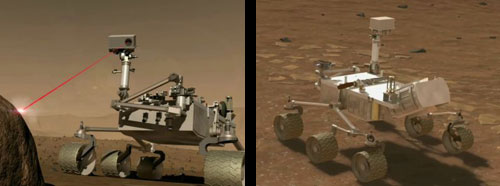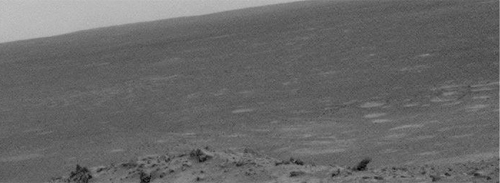By Evan Ackerman

Every two years or so, NASA gets its act together and sends another spacecraft to Mars. This year the spacecraft is Phoenix, a stationary lander kind of like Viking 1 and 2. In 2009, NASA will be sending another rover, much larger and more capable than either Sojourner or Spirit/Opportunity, called the Mars Science Laboratory (MSL).
MSL weighs in at about 1760 pounds, with almost 150 pounds of scientific instruments, including high-def stereo cameras, zoom lenses that can pick out 10 centimeter objects from 1 kilometer away, and sample analysis tools inside the rover’s body. Mounted on the mast of the rover is a laser spectrometer that can vaporize small pieces of rock from up to 13 meters away to determine their composition. The laser has a power output of 1 gigawatt, which is (only?) five times more powerful than Wicked Lasers Spyder Series laser that we reviewed last year. [Evan, I’m afraid you’ve got your conversions wrong. The Spyder was 250mW. That’s miliWatts, as in it takes ten times that just to have 2.5W. And, well, about 400,000,000 times that to get to a gigawatt. This means the MSL laser is four billion times stronger than the Spyder series. That’s assuming I got my own conversions right. Anyone? -Ed.]
More info on the rover’s ass, plus a very cool video, after the jump.
MSL will most likely be powered by a radioisotope thermoelectric generator (RTG), since solar panels won’t be able to provide enough power. The RTG is basically a microwave sized nuclear reactor that hangs off the back of the rover. [See update below. -Ed.] What with this, the lack of pretty solar panels, the boxy body and gangly wheel system, and the off-center mast, this is a pretty ugly looking rover. Of course, it’s been designed to most effectively carry out it’s mission, but come on NASA, making the rover a little bit cuter would do wonders for your image.
Since MSL is so much bigger than previous Mars rovers, which all used giant bouncy airbags to land, the entry/descent/landing technique had to be completely reinvented for the 2009 mission. The following video, rendered by the totally awesome Maas Digital [See update below. -Ed.], provides a photorealistic impression of how it’s all going to work, along with some of the instrumentation on the rover itself:
If you haven’t been keeping up with the current two Mars rovers, I can’t really blame you, since they haven’t blown up or anything and therefore have received virtually no media coverage… But they totally deserve media coverage precisely because they’re still going strong. Originally estimated at 90 days of operation, Spirit has been operational on Mars for over twelve hundred days. It lost the use of one of it’s wheels almost five hundred days ago, at which point the engineers started driving the rover backwards, dragging the dead wheel to create trenches for soil analysis. Opportunity, meanwhile, has driven nearly seven miles from it’s landing site and is currently looking for a safe way down into a large crater. Part of the reason for the 90 day “warranty” on both rovers was the assumption that dust would gradually accumulate on the solar panels, starving the rovers for power over a period of time. Amazingly, both rovers are in fact operating at near peak efficiency thanks to little Martian dust devils, which occasionally blow the solar panels clean. Spirit even managed to catch one on camera:

Mars is so cool.
[ Mars Science Laboratory ] VIA [ The Planetary Society ]
Update: So, NASA’s JPL media relations office has been in touch to kindly correct us on a few facts:
– A radioisotope thermoelectric generator uses the continuous heat of radioactive decay, but not a chain reaction, so it is not correct to refer to it as a nuclear reactor.
– The animation video of this mission was created by JPL, not Maas Digital, though Dan Maas has done great animation videos of other JPL-managed missions.










